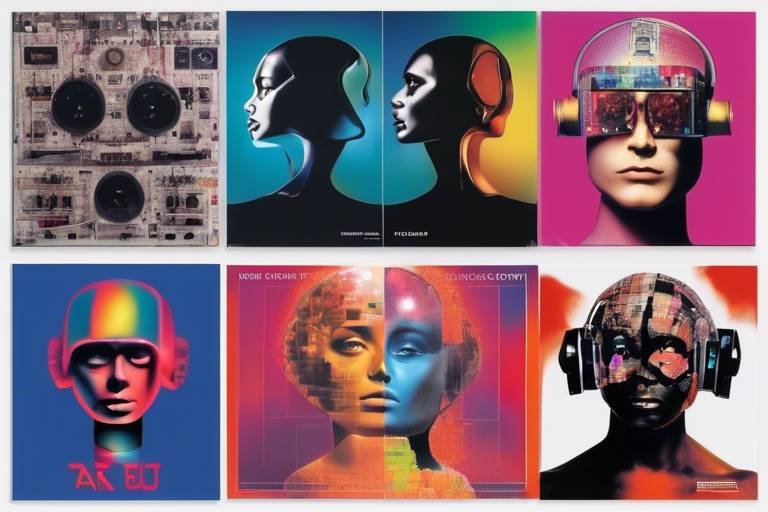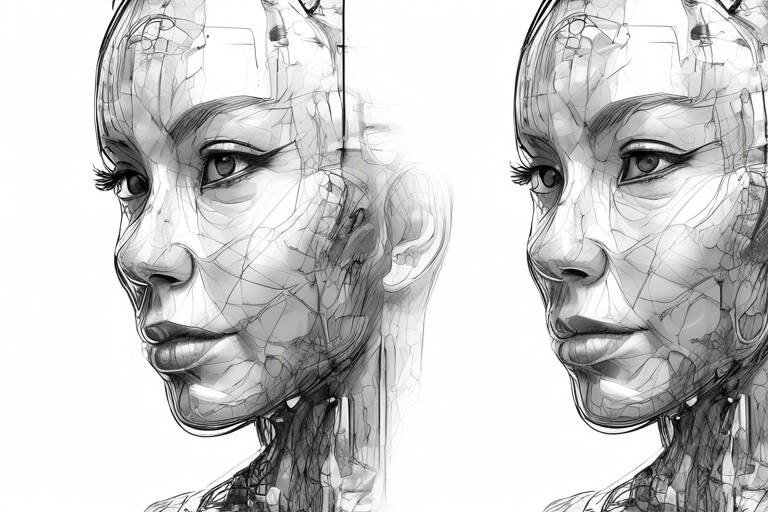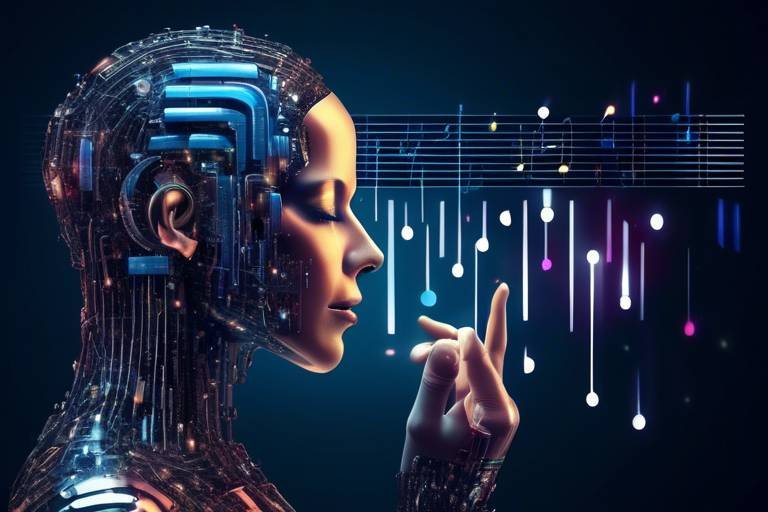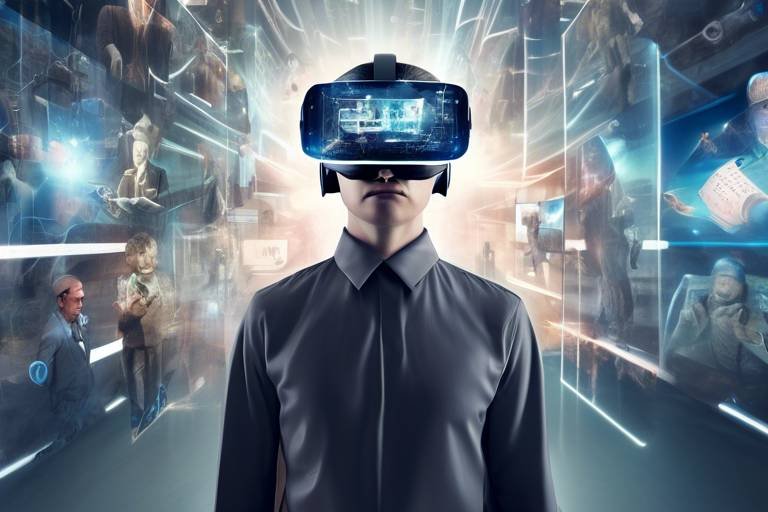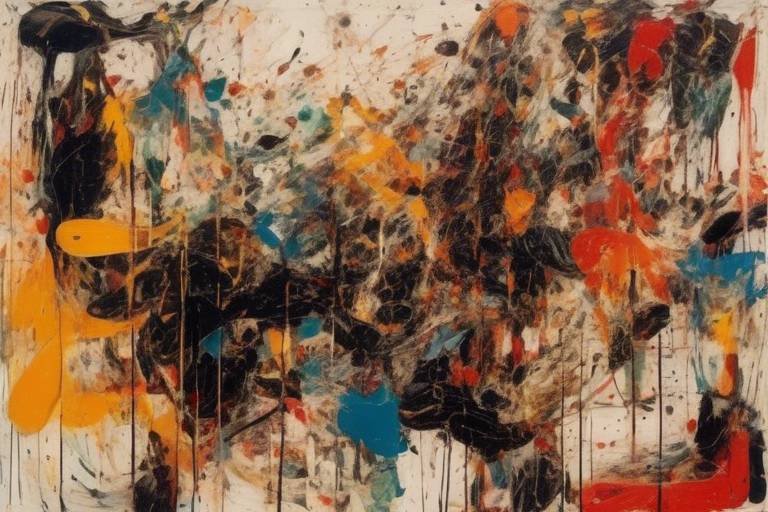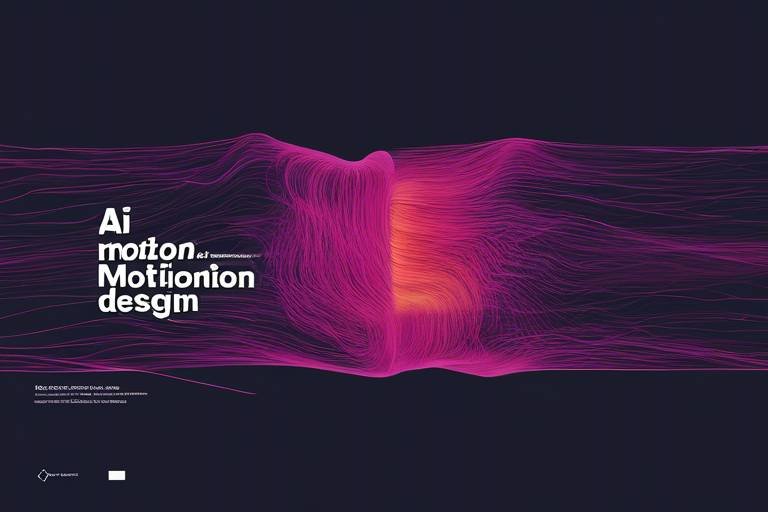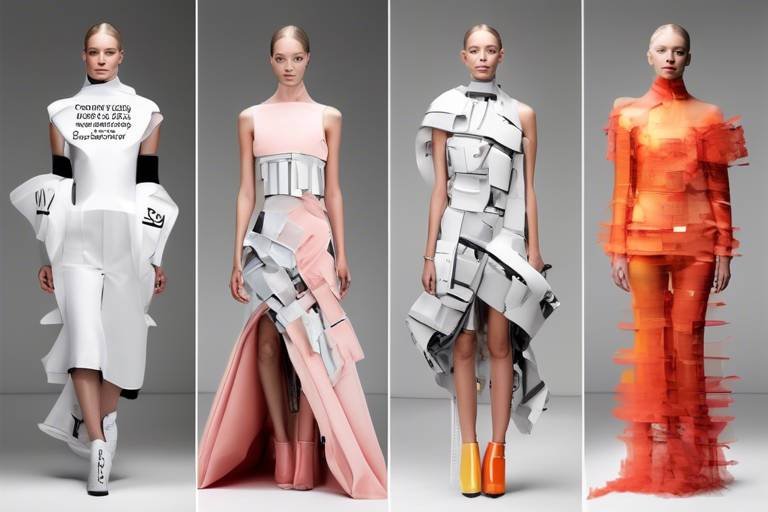The Evolution of AI in Album Cover Art Design
The world of music is a vibrant tapestry woven with sounds, emotions, and stories. Yet, one of the most captivating aspects often lies in the visual representation of these auditory experiences: the album cover art. Over the years, album covers have evolved from simple, often hand-drawn designs to complex, visually stunning pieces that can capture the essence of an artist's work. With the rise of artificial intelligence (AI), we are witnessing a revolutionary transformation in how these covers are conceived and created. This article delves into the profound impact that AI is having on album cover art, reshaping not only the design process but also the broader music industry.
To truly appreciate the evolution of album cover art, it's essential to look back at its rich history. The earliest album covers were often simple and functional, serving primarily to protect the vinyl records within. However, as the music industry grew, so did the artistic ambition behind these covers. Influenced by various artistic movements such as Surrealism, Pop Art, and Abstract Expressionism, album covers began to reflect the cultural zeitgeist of their times.
For instance, the iconic cover of The Beatles' "Sgt. Pepper's Lonely Hearts Club Band" is a prime example of how album art can transcend mere representation to become a cultural artifact. The use of vibrant colors, eclectic imagery, and a collage of characters from different backgrounds not only captured the spirit of the 1960s but also set a new standard for artistic expression in music. This historical context lays the groundwork for understanding how AI is now stepping into this rich tradition, offering new tools and possibilities for artists and designers alike.
As technology advanced, so did the methods of creating album art. The rise of digital art has opened up a world of possibilities for musicians and graphic designers. Artists can now utilize software tools that allow for intricate designs and effects that were once impossible with traditional methods. This transition has not only made the design process more efficient but has also expanded the creative horizons for album art.
Digital tools enable artists to experiment with various styles, from photorealism to abstract designs, often incorporating elements that blend photography, illustration, and typography seamlessly. The ability to manipulate images and create digital collages has led to a new wave of creativity that resonates with the contemporary audience.
Graphic design trends play a crucial role in shaping the aesthetics of album covers. Over the decades, styles have shifted dramatically, influenced by cultural movements and technological advancements. For example, the minimalist designs of the late 2000s contrasted sharply with the elaborate, psychedelic covers of the 1960s.
The current trend leans towards bold colors and striking visuals, often accompanied by typography that reflects the genre of music. From the gritty aesthetics of punk rock to the sleek designs of electronic music, the visual representation is an integral part of the music experience, making it essential for artists to stay ahead of these trends.
Typography is not just about choosing a font; it's about conveying the mood and genre of the music. The right typeface can evoke emotions and set expectations even before a listener presses play. For instance, a bold, angular font might suggest a heavy metal album, while a delicate script might be more fitting for a romantic ballad.
As designers experiment with typography, they often create custom fonts that become synonymous with an artist's brand. This fusion of music and visual identity is vital in today's market, where first impressions can make or break an album's success.
Color theory is another critical element that significantly influences album cover design. Different colors evoke different emotions and can dramatically affect the viewer's perception. For example:
- Red: Passion, energy, and excitement
- Blue: Calmness, trust, and serenity
- Yellow: Happiness and optimism
Understanding how to effectively use color can enhance the music experience, creating a visual connection that resonates with listeners on a deeper level. As AI tools become more sophisticated, they can analyze color trends and suggest palettes that align with the emotional tone of the music, further bridging the gap between sound and sight.
Enter AI. The emergence of artificial intelligence in album cover design is a game changer. With algorithms capable of analyzing vast amounts of data, AI can generate unique artwork that reflects current trends and styles. This technology allows artists to explore new creative avenues, pushing the boundaries of what is possible in visual art.
AI tools can assist in brainstorming ideas, generating initial concepts, and even creating finished pieces that are both innovative and eye-catching. This collaborative process between human creativity and machine efficiency is redefining the landscape of album art, making it more accessible for emerging artists who may not have the resources for traditional design.
Various AI tools are revolutionizing the way album covers are designed. From software that generates images based on keywords to applications that offer style transfer capabilities, the creative possibilities are endless. Some notable tools include:
- DALL-E: An AI model that creates images from textual descriptions, allowing artists to visualize concepts directly from their ideas.
- DeepArt: This tool uses neural networks to apply artistic styles to images, enabling unique reinterpretations of existing artwork.
- Runway ML: A platform that allows for real-time collaboration between artists and AI, making the design process more interactive and dynamic.
These technologies not only streamline the design process but also inspire artists to think outside the box, creating album covers that are not just visually appealing but also conceptually rich.
Generative art, powered by AI algorithms, allows for the creation of unique and dynamic album covers. This approach enables artists to produce a multitude of variations from a single concept, providing a wealth of options to choose from. Imagine a musician who can generate dozens of cover designs in a matter of minutes, each with its own flair and style—this is the future AI promises.
The application of generative art in album design is transforming how visual artists work, blurring the lines between artist and machine. It fosters a new kind of creativity where the artist acts as a curator, selecting the most compelling designs from an array of AI-generated options.
AI facilitates collaboration between artists and technology, creating a synergistic relationship that enhances the creative process. Musicians and designers can now work together with AI to produce stunning visual representations of their music. This collaboration allows for real-time feedback and adjustments, making the design process more fluid and responsive to the artist's vision.
As we move forward, the partnership between human creativity and AI capabilities will likely become the norm in album cover design. This evolving relationship not only enriches the artistic landscape but also democratizes the process, allowing more voices to be heard and seen in the music industry.
- What is the role of AI in album cover design? AI assists in generating artwork, analyzing trends, and providing tools for artists to explore creative possibilities.
- How has digital art changed album cover aesthetics? Digital art has expanded the range of techniques and styles available, allowing for more intricate and innovative designs.
- Can AI create album covers without human input? While AI can generate designs, human creativity and vision are still essential for creating meaningful and impactful artwork.

The Historical Context of Album Cover Art
To truly appreciate the evolution of album cover art, it's essential to dive into its historical context. The journey begins in the early 20th century, a time when music was primarily experienced through phonographs and shellac records. These early formats had minimal visual representation, often featuring simple, monochrome labels that provided little more than the artist's name and song title. However, as the music industry began to flourish, so did the need for more engaging and visually appealing packaging.
In the 1950s and 1960s, album cover art took a significant leap forward, coinciding with the rise of rock 'n' roll and the counterculture movement. Artists and record labels recognized that an album cover could serve as a powerful marketing tool, reflecting the music's essence and the artist's identity. This period saw the emergence of iconic designs, such as The Beatles' "Sgt. Pepper's Lonely Hearts Club Band," which not only captivated audiences but also pushed the boundaries of artistic expression. The album cover became a canvas for creativity, incorporating vibrant colors, intricate illustrations, and even photography.
As we moved into the 1970s and 1980s, album art continued to evolve, driven by advancements in printing technology and the burgeoning popularity of vinyl records. This era introduced us to the concept of the gatefold album, which allowed for larger artwork and more elaborate designs. Artists like Pink Floyd and David Bowie utilized this format to create visually stunning covers that were almost works of art in their own right. The combination of music and visual art became increasingly intertwined, leading to a deeper appreciation of album covers as a form of cultural expression.
During this time, various artistic movements also influenced album cover design. The psychedelic art movement brought swirling colors and surreal imagery, while the minimalist movement favored simplicity and stark contrasts. Each movement contributed to the rich tapestry of album art, allowing musicians to convey their messages and emotions through visual means.
By the 1990s, the advent of digital technology further transformed the landscape of album cover art. Designers began experimenting with computer-generated imagery (CGI), which opened up a whole new realm of possibilities. Album covers could now feature intricate designs that were previously unimaginable, ranging from hyper-realistic graphics to abstract compositions. This shift not only changed the aesthetic of album art but also the way artists collaborated with designers. The fusion of technology and creativity led to the birth of a new era, where album covers became a crucial part of an artist's branding and identity.
In summary, the historical context of album cover art reflects a dynamic interplay between music and visual culture. From the simplistic designs of the early 20th century to the vibrant and complex artworks of today, album covers have evolved into a vital aspect of the music experience. They serve not just as packaging but as a visual narrative that enhances our connection to the music itself.

The Rise of Digital Art in Music
In the not-so-distant past, album cover art was primarily the domain of traditional artists wielding brushes, paints, and a hefty dose of imagination. However, as technology advanced, we began to witness a remarkable transformation in the way album covers are created. Enter the realm of digital art, a game-changer that has not only revolutionized the aesthetics of music albums but also redefined the creative process itself. Today, musicians and designers are harnessing digital tools to explore new techniques, styles, and concepts, paving the way for a vibrant fusion of art and music that captivates audiences worldwide.
Digital art has opened up a treasure trove of possibilities for artists. With software like Adobe Photoshop, Illustrator, and various AI-driven design tools, the creative potential is virtually limitless. Imagine being able to manipulate images with a few clicks, experimenting with colors, textures, and layouts in real-time. This newfound freedom allows artists to push the boundaries of their creativity, crafting album covers that are not just visually stunning but also deeply connected to the music they represent. The ability to iterate quickly and easily means that artists can explore multiple concepts before settling on the perfect design, a luxury that traditional methods simply couldn’t afford.
Moreover, the rise of digital art has democratized the process of album cover creation. No longer is it necessary to hire a high-profile designer or have extensive art training to create eye-catching visuals. Today, aspiring musicians and independent artists can utilize user-friendly software and online platforms to produce professional-quality artwork. This shift has led to a surge of creativity in the industry, with a diverse array of styles and approaches emerging from all corners of the globe.
As we delve deeper into the impact of digital art on album cover design, it’s essential to recognize the influence of graphic design trends that have evolved alongside these technological advancements. From minimalism to maximalism, each trend brings its own flair and character, shaping the visual language of music. For instance, the retro aesthetic has made a significant comeback, with artists embracing vintage typography and color palettes reminiscent of the 70s and 80s. This revival not only appeals to nostalgia but also connects contemporary music with its historical roots.
In addition to aesthetics, the integration of typography and color theory into digital art has also transformed the way we perceive album covers. The choice of font can evoke specific emotions and set the tone for the entire album. Similarly, color choices can influence how a viewer feels about the music before even hearing a single note. For example, a vibrant, colorful cover might suggest an upbeat, energetic vibe, while darker tones could hint at a more somber or introspective sound.
As we look towards the future, it's clear that digital art will continue to play an essential role in the music industry. With the advent of AI tools and generative design, the possibilities are expanding even further. Artists are now able to create dynamic and unique album covers that reflect not just their music but also the evolving landscape of technology and creativity. The marriage of art and music has never been more exciting, and as we embrace these advancements, the potential for innovation is truly limitless.
In summary, the rise of digital art in music has transformed album cover design from a traditional craft into a dynamic and inclusive process. With tools that empower creativity and a landscape that encourages experimentation, artists today are creating stunning visuals that resonate with listeners on multiple levels. As we continue to explore the intersection of technology and art, one can only wonder what the next evolution will bring to the world of album covers.

Influence of Graphic Design Trends
Graphic design trends have a profound impact on the aesthetics of album covers, shaping how music is visually represented and perceived. Over the decades, various movements have emerged, each bringing its unique flair and philosophy to the world of design. For instance, the Pop Art movement of the 1960s, characterized by vibrant colors and bold imagery, revolutionized album art with its playful take on consumer culture. Artists like Andy Warhol famously transformed the mundane into the extraordinary, creating iconic covers such as The Velvet Underground & Nico, which remains a touchstone for album art even today.
As we moved into the digital age, the minimalist design trend took center stage. This style emphasizes simplicity and functionality, often using clean lines and ample white space. The shift towards minimalism can be seen in album covers like Bon Iver's self-titled album, where the focus is on subtlety and the essence of the music rather than overwhelming visuals. This trend resonates with audiences seeking authenticity and clarity in a world inundated with noise.
Moreover, the rise of retro aesthetics in recent years has brought a nostalgic vibe back to album covers. Artists are increasingly drawing inspiration from the 80s and 90s, using vintage typography, grainy textures, and color palettes reminiscent of old-school cassette tapes and vinyl records. This revival not only appeals to older generations but also captures the attention of younger audiences who crave authenticity and a connection to the past.
Another significant trend is the integration of mixed media in album art. Artists are now blending photography, illustration, and digital art to create visually stunning pieces that tell a story. This approach allows for greater creativity and expression, making each album cover a unique work of art. For example, the cover of Currents by Tame Impala showcases a mesmerizing blend of colors and shapes, perfectly encapsulating the psychedelic sound of the music within.
In conclusion, graphic design trends are not just fleeting fads; they are reflective of cultural shifts and technological advancements. As artists and designers continue to experiment and push boundaries, the influence of these trends on album cover art will undoubtedly evolve, paving the way for new styles and expressions in the music industry.

The Role of Typography in Album Covers
Typography is more than just a tool for communication; it’s an essential element in the visual storytelling of album covers. Imagine flipping through a record collection and being drawn to a cover not just by its imagery, but by the way the title dances across the front. The font choice, size, and arrangement can evoke emotions and set the tone for the music before a single note is played. In the world of album art, typography can be a silent yet powerful storyteller, whispering hints about the genre, mood, and even the artist’s personality.
For instance, a heavy metal album might feature sharp, jagged fonts that scream intensity and raw energy, while a soft jazz album might opt for elegant, flowing script that suggests sophistication and smooth melodies. This intentional use of typography creates an immediate connection with the audience, as it aligns their expectations with what they are about to experience. In this way, typography serves as a visual cue, guiding listeners through a sensory journey even before they press play.
The impact of typography extends beyond mere aesthetics; it plays a crucial role in branding. Artists like Taylor Swift and Metallica have established unique typographic styles that are instantly recognizable. Fans can identify their favorite artists not just by their music, but by the way their names are presented on album covers. This brand consistency is vital in a crowded market where countless albums vie for attention. A well-crafted typographic design can elevate an album from just another release to a memorable piece of art that fans will cherish.
Moreover, the evolution of technology has democratized typography in album art. With tools like Adobe Illustrator and Canva, musicians and designers can experiment with typography in ways that were once reserved for professional graphic designers. This accessibility allows for a wider range of creative expression, enabling artists to play with custom fonts and layouts that reflect their unique vision.
To illustrate this, consider the following table that compares different typographic styles and their associated genres:
| Genre | Typical Typography Style | Emotional Impact |
|---|---|---|
| Rock | Bold, Distressed Fonts | Powerful, Edgy |
| Pop | Clean, Modern Fonts | Bright, Uplifting |
| Jazz | Elegant, Script Fonts | Sophisticated, Smooth |
| Hip-Hop | Graffiti-inspired Fonts | Urban, Bold |
In conclusion, typography in album covers is a vital aspect of music branding and visual identity. It serves not only to attract attention but also to convey the essence of the music within. As artists continue to push the boundaries of creativity, we can expect to see even more innovative uses of typography that challenge traditional norms and resonate with audiences on a deeper level.
- Why is typography important in album covers? Typography helps convey the mood and genre of the music, creating an immediate connection with the audience.
- How does typography influence branding for musicians? Consistent typographic styles help establish a recognizable brand identity, making it easier for fans to identify their favorite artists.
- Can anyone create effective typography for album covers? Yes, with the right tools and creativity, musicians and designers can experiment with typography to create unique designs that reflect their vision.

Color Theory and Its Impact
Color theory is an essential aspect of design that influences how we perceive and react to visual stimuli. In the realm of album cover art, color choices are not merely decorative; they serve a deeper purpose by evoking emotions and setting the tone for the music within. Each color carries its own psychological weight, and understanding these associations can help artists create covers that resonate with their audience on a profound level.
For instance, consider the emotional responses elicited by different colors:
- Red: Often associated with passion, energy, and intensity, red can create a sense of urgency or excitement. It's a popular choice for rock and pop albums, where the music aims to energize and engage.
- Blue: This color typically conveys calmness, trust, and sadness. It’s frequently used in genres like blues and jazz, reflecting the mood of the music.
- Yellow: Bright and cheerful, yellow can evoke feelings of happiness and optimism. This color is often seen in upbeat pop music covers, inviting listeners to experience joy.
- Black: A color that symbolizes sophistication, power, and mystery, black is often used in genres like metal and hip-hop, adding an air of intrigue and depth.
- Green: Representing nature and tranquility, green can evoke feelings of peace and renewal, making it a fitting choice for folk or acoustic albums.
By carefully selecting colors that align with the themes and emotions of their music, artists can create a more immersive experience for their listeners. For example, an album cover featuring dark, moody colors can prepare the audience for a somber listening experience, while bright, vibrant hues can signal a lively and energetic album. Moreover, the combination of colors can also create interesting contrasts that draw the eye and provoke curiosity.
In addition to individual colors, the contrast and harmony between colors also play a significant role in design. High contrast can make elements stand out, capturing attention and emphasizing key aspects of the artwork. On the other hand, harmonious color schemes can create a sense of unity and balance, making the cover feel cohesive and thoughtfully designed. This interplay of colors can significantly enhance the overall impact of an album cover, making it not just a visual treat but also a powerful representation of the music it encapsulates.
As we see more artists embracing innovative design techniques, including the use of artificial intelligence, the possibilities for color application in album covers are expanding. AI tools can analyze color trends and suggest palettes that resonate with current audiences, helping artists to stay relevant and impactful in a rapidly changing industry. In this way, color theory continues to evolve, intertwining with technology to shape the future of album art.
- What is the significance of color in album cover art? Color plays a crucial role in conveying emotions and themes, influencing how listeners perceive the music.
- How can AI assist in color selection for album covers? AI can analyze trends and suggest color palettes that resonate with audiences, enhancing the visual appeal of album art.
- Are there specific colors associated with certain music genres? Yes, different genres often use specific colors to reflect their themes, such as red for rock or blue for jazz.

Emergence of AI in Design
The emergence of artificial intelligence (AI) in design has been nothing short of revolutionary, especially in the realm of album cover art. Traditionally, creating an album cover involved a significant amount of human creativity, artistic skill, and time-consuming processes. However, with the advent of AI technologies, the landscape has dramatically shifted. Imagine a world where artists can collaborate with intelligent software to produce stunning visuals that resonate with their music’s essence. This is not just a fantasy; it’s happening right now!
AI tools are now capable of analyzing vast datasets of existing album covers, identifying trends, and generating unique designs that are both innovative and visually appealing. For instance, AI algorithms can learn from thousands of artworks, understanding what colors, shapes, and styles evoke specific emotions. This means that musicians can now have access to a plethora of design options tailored to their artistic vision without the usual constraints of traditional methods.
Moreover, the integration of AI in design processes has opened up new avenues for creativity. Artists can input their ideas or themes into AI systems, which then generate multiple design variations. This collaborative process not only enhances creativity but also speeds up the design phase significantly. Instead of spending weeks or months on a single cover, artists can now experiment with numerous concepts in a matter of hours.
To illustrate the impact of AI on album cover design, consider the following table that highlights some of the most notable AI tools currently being used:
| AI Tool | Description | Key Features |
|---|---|---|
| Artbreeder | A platform that uses generative adversarial networks (GANs) to create and modify images. |
|
| DeepArt | Transforms photos into artworks using deep learning algorithms. |
|
| Runway ML | A creative suite that empowers artists with machine learning tools for various media. |
|
As we witness the rise of AI in design, it's essential to acknowledge that this technology is not here to replace artists. Instead, it serves as a powerful ally that enhances the creative process. Just like a musician uses an instrument to express their art, designers can now use AI as a tool to push the boundaries of visual storytelling. The synergy between human creativity and artificial intelligence is paving the way for a new era in album cover design, where the only limit is the imagination.
In conclusion, the emergence of AI in design heralds a future where creativity knows no bounds. As artists and designers embrace these technologies, we can expect to see a fascinating evolution in album cover art, one that captivates audiences and enhances the overall music experience.
- How does AI improve album cover design?
AI enhances album cover design by providing artists with innovative tools that generate unique visuals and streamline the creative process, allowing for more experimentation and faster turnaround times. - Are AI-generated designs considered art?
Yes, AI-generated designs can be considered art, as they are the result of creative input from artists combined with the capabilities of AI, creating a new form of artistic expression. - Can AI replace human designers?
No, AI serves as a tool to assist human designers, enhancing their creativity rather than replacing them. The human touch remains essential in the artistic process.

AI Tools Transforming Album Art Creation
In today’s fast-paced digital world, artificial intelligence is not just a buzzword; it's a game-changer, especially in the realm of album art creation. The traditional methods of designing album covers, which often required extensive manual labor and artistic skill, are being transformed by innovative AI tools that streamline the creative process and expand the boundaries of imagination. Imagine being able to generate stunning visuals in a matter of seconds, where once it took days or even weeks. The rise of AI in album art design is akin to having a creative partner who never tires and always brings fresh ideas to the table.
These AI tools utilize advanced algorithms and machine learning techniques to analyze vast datasets of existing artwork, understanding patterns, styles, and trends. This capability allows them to create unique designs that resonate with specific genres or themes. For instance, an AI can study thousands of punk rock album covers and generate new artwork that embodies the raw energy and rebellious spirit of that genre, all while providing a fresh perspective that a human artist might not have considered. The implications are profound, as musicians can now access a wellspring of creativity that was previously unimaginable.
Some of the most notable AI tools making waves in the music industry include:
- DeepArt: This tool uses deep learning techniques to transform images into artwork inspired by famous artists. Musicians can upload a photo and choose a style, resulting in a unique piece of album art that reflects their vision.
- Artbreeder: By blending images and allowing users to adjust parameters, Artbreeder enables artists to create diverse variations of their album covers. It’s like mixing colors on a palette, but digitally!
- Runway ML: This platform offers a suite of creative tools powered by AI, allowing for real-time collaboration and experimentation, making it easier for musicians and designers to bring their ideas to life.
Moreover, these tools are not just about creating art; they also foster a collaborative environment where musicians and visual artists can work together seamlessly. By integrating AI into the design process, artists can brainstorm ideas and generate multiple iterations of a concept without the usual constraints of time and resources. This collaborative approach is reminiscent of a jam session, where each participant contributes their unique flair, resulting in a rich tapestry of creativity.
As we look ahead, it’s clear that AI is not just enhancing album art creation; it’s revolutionizing it. The tools available today empower artists to push the limits of their creativity, producing album covers that are not only visually stunning but also deeply connected to the music they represent. In this new era of digital artistry, the fusion of technology and creativity is paving the way for a future where the possibilities are as limitless as the imagination itself.
Q1: How does AI create album art?
AI algorithms analyze existing artwork to understand styles and trends, enabling them to generate unique designs based on the input provided by users.
Q2: Can AI tools replace human artists?
While AI tools can assist in the creative process and generate artwork, they are best used as collaborators rather than replacements, as human creativity and intuition remain irreplaceable.
Q3: Are AI-generated album covers considered original art?
Yes, AI-generated artwork can be considered original as it combines various influences and styles to create something new, although the degree of originality may vary based on the input data.

Generative Art and Its Applications
Generative art is a fascinating intersection of creativity and technology, where algorithms and artificial intelligence come together to produce visually stunning artwork. In the realm of album cover design, this innovative approach is reshaping how musicians express their artistic vision. Imagine an album cover that evolves with each listen, adapting its visuals to reflect the mood and energy of the music. This is not just a dream; it's a reality made possible by generative art.
At its core, generative art relies on algorithms to create images, often using randomization and predefined rules to produce unique designs. This method allows artists to explore an infinite variety of styles and concepts without the constraints of traditional art forms. For musicians, this means their album covers can be as dynamic and multifaceted as the sounds they create. The result? A visual representation of music that resonates deeply with fans and enhances the overall listening experience.
One of the key applications of generative art in album cover design is its ability to create personalized artwork. With AI tools, artists can input specific parameters, such as color schemes, shapes, and even thematic elements that reflect their music's essence. The AI then generates a plethora of designs, giving artists a rich palette of options to choose from. This process not only saves time but also sparks creativity, as artists can discover unexpected visual outcomes that may inspire new musical directions.
Moreover, generative art can be programmed to respond to real-time data. For instance, an album cover could change based on the listener's geographical location, time of day, or even their mood, as determined by biometric feedback. This level of interactivity transforms the static nature of traditional album art into a living, breathing entity that evolves alongside the listener's experience. Such innovations not only captivate audiences but also create a deeper connection between the artist and their fans.
To further illustrate the impact of generative art in album cover design, consider the following table showcasing notable examples:
| Album | Artist | Generative Art Feature |
|---|---|---|
| “The Infinite” | DJ Spooky | Dynamic visuals that change with each track. |
| “A.I. Generated Dreams” | Various Artists | Personalized covers based on listener data. |
| “Generative Visions” | Ryoji Ikeda | Visuals created from sound wave data. |
As we look to the future, the possibilities for generative art in album cover design are virtually limitless. With advances in AI technology, artists can push the boundaries of their creativity, giving rise to new genres of music and visual art that we have yet to imagine. This synergy between music and technology not only enriches the artistic landscape but also invites listeners to engage with music in entirely new ways.
In conclusion, generative art is not just a trend; it represents a profound shift in how album covers are created and experienced. As artists embrace this technology, we can expect to see an explosion of creativity that reflects the diverse and ever-evolving nature of the music industry. The future of album cover art is bright, and generative art will undoubtedly play a pivotal role in shaping its trajectory.
- What is generative art? Generative art is artwork created using algorithms and AI, allowing for unique and often unpredictable designs.
- How does generative art apply to album covers? It enables artists to create dynamic, personalized, and interactive visuals that reflect their music.
- Can generative art change over time? Yes, generative art can be programmed to evolve based on various factors, such as listener data or real-time inputs.
- What are some benefits of using generative art in music? It saves time, sparks creativity, and enhances the connection between artists and fans through interactive experiences.

Collaborative Design Processes with AI
The intersection of art and technology has always been a fascinating realm, but with the advent of artificial intelligence, this collaboration has reached unprecedented heights. Musicians and designers are now leveraging AI to enhance their creative processes, leading to a synergy that was once unimaginable. Imagine a world where the artist's vision is amplified by intelligent tools that can suggest, adapt, and even create alongside them. This is the reality of collaborative design processes with AI.
At its core, AI acts as a digital assistant, providing artists with a myriad of options that can spark new ideas and push creative boundaries. For instance, tools like DeepArt and RunwayML allow artists to input their concepts and receive generated artwork that aligns with their vision. This not only speeds up the design process but also opens the door to unconventional aesthetics that might not have been explored otherwise. The beauty of this collaboration lies in the balance; while AI can generate stunning visuals, the human touch remains essential in guiding the art's final direction.
Moreover, the collaborative process is not just about the initial creation. It extends to iterative feedback loops where artists can refine AI-generated designs. For example, an artist might start with a base image generated by AI, then adjust colors, add textures, or overlay typography to create a unique piece. This back-and-forth enhances the design while ensuring that the final product resonates with the artist's intent. In essence, AI serves as both a collaborator and a catalyst, inspiring artists to think outside the box.
In addition, collaborative design processes with AI facilitate a more inclusive creative environment. Artists from various backgrounds can utilize these technologies to express their unique styles without the steep learning curve traditionally associated with graphic design software. This democratization of art creation means that more voices can be heard in the music industry, enriching the visual landscape of album covers.
As we delve deeper into this collaborative space, we can see how AI is not just a tool but a partner in the creative journey. The result? A fusion of human creativity and machine intelligence that produces album covers that are not only visually stunning but also deeply reflective of the music they represent. This partnership is set to redefine the future of album art, making it more dynamic and engaging than ever before.
- How does AI enhance the creative process for album cover design?
AI provides artists with innovative design options and inspiration, allowing for quicker iterations and exploration of unique aesthetics. - Can AI replace human designers in album art creation?
No, AI acts as a collaborator rather than a replacement. The human touch is essential for guiding the final design and ensuring it resonates with the artist's vision. - What tools are commonly used for AI-assisted album cover design?
Popular tools include DeepArt, RunwayML, and Adobe's AI features, which help artists generate and refine artwork efficiently.
Frequently Asked Questions
- How has AI changed the way album covers are designed?
AI has introduced innovative tools that allow artists to generate unique designs quickly and efficiently. With algorithms capable of understanding artistic styles, AI can help create artwork that resonates with the music's mood, enhancing the overall aesthetic experience for listeners.
- What are some popular AI tools used in album cover design?
There are several AI tools making waves in album cover design, including DeepArt, Artbreeder, and RunwayML. These platforms enable artists to experiment with generative art, allowing for endless creativity and exploration of visual styles that were previously hard to achieve.
- Can AI replace human designers in album art creation?
While AI can generate impressive designs, it doesn't replace the human touch in art. The emotional depth and personal connection that a human artist brings to their work are irreplaceable. Instead, AI acts as a collaborator, enhancing the creative process rather than replacing it.
- What role does typography play in album cover design?
Typography is crucial in conveying the genre and mood of the music. The choice of fonts can evoke different emotions and set the tone for what listeners can expect. A well-designed album cover uses typography to complement the artwork, making it an integral part of the overall design.
- How does color theory influence album cover art?
Color theory significantly impacts how viewers perceive an album. Different colors can evoke specific emotions—like blue for calmness or red for excitement. By understanding color psychology, designers can create covers that not only attract attention but also resonate emotionally with the audience.
- What is generative art, and how is it applied in album covers?
Generative art refers to artwork created through algorithms and computer software. In album covers, this means artists can create dynamic visuals that change or evolve, offering a fresh experience with each viewing. This technology pushes the boundaries of traditional design, making each album cover a unique piece of art.
- How can artists collaborate with AI in their design process?
Artists can use AI as a brainstorming partner, generating ideas or visual elements that they can refine. By feeding AI tools with specific parameters and styles, musicians and designers can explore new creative avenues, resulting in stunning visuals that reflect their artistic vision.

